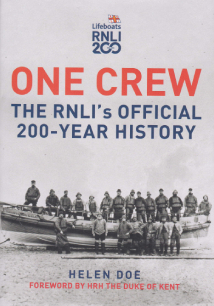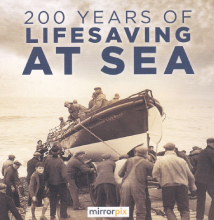Bicentenary books about the beloved RNLI
One Crew, by Helen Doe, and 200 Years of Lifesaving at Sea, by Mirrorpix
 The Royal National Lifeboat Institution (always known as the RNLI) celebrated its 200th anniversary on 4 March this year. To mark the occasion, two attractive new books have been published: an official history and a 'life in pictures'.
The Royal National Lifeboat Institution (always known as the RNLI) celebrated its 200th anniversary on 4 March this year. To mark the occasion, two attractive new books have been published: an official history and a 'life in pictures'.
One Crew: the RNLI's official 200-year history has already proved so popular that it's on its second print run. It's a measure of how much the RNLI is loved by the British and Irish public, who donate eagerly to the volunteer lifesaving service and show heartfelt gratitude for its rescues.
Experienced maritime author Helen Doe follows a straightforward chronological model for her history. She shows how the Institution was run from the very start on a volunteering model, with retired naval sailors enlisted to help local people with the rescues. Fundraising was also crucial, to pay for sturdy lifeboats and give financial awards to those who had put their own lives at risk to rescue others.
The need for the lifeboat service was well-understood in early-19th century Britain, and there was also a widespread dedication to charitable giving as part of people's civic and religious duty. So it wasn't too difficult to get the Institution going, but support has sometimes waned over the years, and One Crew has interesting coverage of how charismatic leaders, high-profile champions and initiatives such as the Lifeboat Saturday Movement turned the RNLI's fortunes around.
The war-torn 20th century saw new kinds of demands on RNLI volunteers, including the rescue of airmen who had ditched into the sea, and the 21st century has brought its own innovations and challenges – from the introduction of RNLI beach lifeguards to Covid and 'small boats' carrying migrants.
Every twist and turn is thoroughly dealt with in this comprehensive official history, which includes useful appendices listing information such as lifeboat classes and current lifeboat stations, as well as an index and bibliography.
 While One Crew does include a few pictures in a glossy central section, these are not the focus of the work, so for images, it's worth also taking a look at another new title: 200 Years of Lifesaving at Sea.
While One Crew does include a few pictures in a glossy central section, these are not the focus of the work, so for images, it's worth also taking a look at another new title: 200 Years of Lifesaving at Sea.
This book tells the story of the RNLI through media images from the Mirrorpix archive, meaning that it tends to focus on notable moments such as the launch of new lifesaving vessels, technological innovations and royal visits.
For the most part, the photographs are grouped by decade, with a black-and-white photo and caption on each page, but there is also an assortment of colour pictures at the end of the book. It's fascinating to see how the boats and equipment changed over the years, but the determined and proud expressions of the volunteers remain much the same.
One Crew: the RNLI's official 200-year history
By Helen Doe
Amberley, £22.99
ISBN: 978 13981 22352
200 Years of Lifesaving at Sea
By Mirrorpix
History Press, £14.99
ISBN: 978 18039 94413
Buy this book in the Nautilus Bookshop
While you're there, why not browse the rest of the titles in our unique maritime bookshop, which sells all the books reviewed on these pages.
Buy nowMore Books
Radio revelry
Barques, Sparks and Sharks, an Orcadian at Sea by Len WilsonSeafarers are known for their story-telling abilities, and Orkney-born Len Wilson does not disappoint.
Mastering our harbours
Harbours and Their Masters: Sailing into nearly every harbour in Britain and Ireland by Mark Ashley-MillerNovice skipper Mark Ashley-Miller recently spent five years circumnavigating the UK and Ireland on his 34ft ketch Good Dog as a charity challenge – interviewing and photographing the harbour masters he met along the way.
The precarious path from piracy to prosperity
The Resurrected Pirate, by Craig S ChapmanThe Resurrected Pirate is a remarkable story told in an engaging way, illustrating for the modern reader the desperately narrow passage between life and death that a seafarer in this period might have to navigate.
Carving out a career
Ships' Figureheads: Famous Carving FamiliesThe decoration of ships with figureheads was a way to present the might of military and mercantile power for centuries. These days, the skills needed to make these sculptures are kept alive by experts such as Andrew Peters, who has worked on restoration projects such as the Cutty Sark tea clipper.
